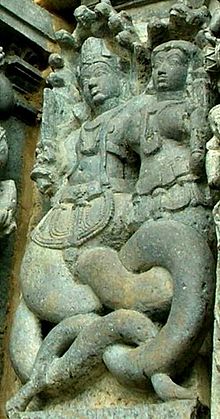Nāga
| Grouping | Legendary creature |
|---|---|
| Sub grouping | Water deity, Tutelary deity, Snake deity |
| Similar creatures | Dragon (related to the Chinese dragon, Japanese dragon, Korean dragon, Vietnamese dragon and Druk) |
| Mythology | Hindu mythology and Buddhist mythology |
| Other name(s) | Nāgī or Nāgiṇī |
| Country | India |
| Region | South Asia and Southeast Asia |
| Habitat | Lakes, Rivers, Ponds, Sacred groves and Caves |
Nāga (IAST: nāgá; Devanāgarī: नाग) is the Sanskrit and Pali word for a deity or class of entity or being taking the form of a very great snake, specifically the king cobra, found in the Indian religions of Hinduism, Buddhism and Jainism. A female nāga is a nāgī or nāgiṇī.
In Sanskrit, a nāgá () is a cobra, the Indian cobra (Naja naja). A synonym for nāgá is phaṇin (). There are several words for "snake" in general, and one of the very commonly used ones is sarpá (). Sometimes the word nāgá is also used generically to mean "snake". The word is cognate with English 'snake', Germanic: *snēk-a-, Proto-IE: *(s)nēg-o- (with s-mobile).
In the great epic Mahabharata, the depiction of nagas tends toward the negative. An epic calls them "persecutors of all creatures", and tells us "the snakes were of virulent poison, great prowess and excess of strength, and ever bent on biting other creatures" (Book I: Adi Parva, Section 20). At some points within the story, nagas are important players in many of the events narrated in the epic, frequently no more evil nor deceitful than the other protagonists, and sometimes on the side of good.
...
Wikipedia

